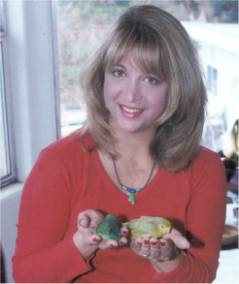Saturday, February 1, 2014
Identification of Male Pacific Parrotlet
Dear Sandee,
My name is Judy, and I am from Wisconsin. I am asking for your help and expertise. I lost my beloved little parrotlet last Sunday. He had been my trusted and faithful companion for the past nine years. He succumed to an accident, and I am absolutely heart broken. He was an exceptional bird with a big personality and heart. My life will not be the same without him. I had been to a local pet store to pick up seed for our cockatiels nine years ago when I first spotted my little Beaker in a fish tank. He looked so tiny and lost. When I approached, he followed me everywhere. When taken out of the tank, he immediately climbed on my shoulder and stole my heart. It was love at first sight, and he came home with me that day.
I am looking to purchase another little bird to love. I have enjoyed your book on parrotlets and wonder if youl have birds for sale at this time. Also, I am confused about the sex of my little Beaker. Beaker was a green celestial parrotlet that the store sold to us as a male. He was olive green with a very faint small area of turquoise blue just behind the eyes but not on the head. His face and underside were lighter with a slight yellow wash. His back side and head almost seemed to have a very light grayish wash. He had absolutely no blue on or under his wings, He did have cobalt blue with indigo highlights on the back rump when you moved his wing feathers. His primary feathers had no blue and from the underside were grayish. The underside coverlets were emerald green. He was a little smaller and shorter than my daughter's green female parrotlet. She is more pear shaped (seems wider below the chest extending into pelvic area). Beaker was sleek all the way. However, when he puffed up, his chest appeared wider. We have pictures that we have posted, and are getting conflicting responses as to Beaker's sex.
I have been told that some male green celestial parrotlets do not have blue on their wings. Is this true? Other say that evidence of a cobalt indigo rump, even though no blue was on the wings, is still indicative of a male. We have also been told that both male and female celestial can have the cobalt-indigo rump, The only way to differentiate the male from the female is by the absence of blue on the wings. I did look at Beaker's wings after he died. There was no significant blue anywhere on his primary top and underside feathers. The coverlets on the under side were emerald green but only one tiny feather among the coverlets above the first primary feather on each wing had a faint turquoise wash--but only one little father in the underside coverlet of each wing. Is that significant? Now, I am totally confused at to Beaker's sex.
I would greatly appreciate your expert advice and am hoping that you have that little bird that we are so desperately are looking to adopt into our loving home.
Thank you, in advance, for you help.
Judy
Dear Judy:
I am so sorry to hear about the loss of your bird. It is always so heartbreaking to lose these little guys. Nine years is a long time for a parrotlet to live these days and I am sure that every day with you was filled with kindness, love and happiness for your little guy. I hope you can find comfort in that.
I do not breed parrotlets any longer as more than 30 years of hand-feeding parrotlets has given me terrible arthritis in my thumb so I can no longer depress a syringe and feed them.
The male Pacific parrotlet is one of the easiest birds to visually sex. Even in color mutations including the albino, the dark cobalt blue on the wings, rumps, backs and streaks behind the eyes are always distinctive and easily observed. In albinos, this coloring can be seen when the bird is placed under a UV light where the color is striking and vibrant. There is no mistaking a male Pacific. Unfortunately, anyone with a keyboard, an opinion and Photoshop can be an expert when it comes to being on the Internet. Now, females from the subspecies of Pacific known as ‘lucida’ often have blue on their rumps, backs and streaks behind the eyes but rarely on the wings. Even if they do, it is always much fainter than the blue on males. This is often the case where people think they have a male because the rump is dark blue but the wings are green; again the bird is not male at all but a female lucida. Unfortunately, hardly ANYONE who has parrotlets these days ever saw a single wild-caught parrotlet. I raised wild-caughts for 15 years before they were no longer allowed to be imported. As someone who saw them come directly out of quarantine (plus we had NO color mutations in the US at the time) ALL male Pacifics have dark blue rumps, wings, backs and eye streaks. If any of those parts of not blue, the bird is a hen.
If you are still confused you are welcome to send me a picture. I can identify your bird in an instant.
Sincerely yours,
Sandee L. Molenda, C.A.S.
The Parrotlet Ranch, Owner, www.parrotletranch.com
A Chattering Bird Builds No Nest.
Camaroonian Phrase
Labels:
Identification of Sex,
Male Pacifics,
Pacifics,
Parrotlets
Subscribe to:
Post Comments (Atom)




No comments:
Post a Comment
Note: Only a member of this blog may post a comment.